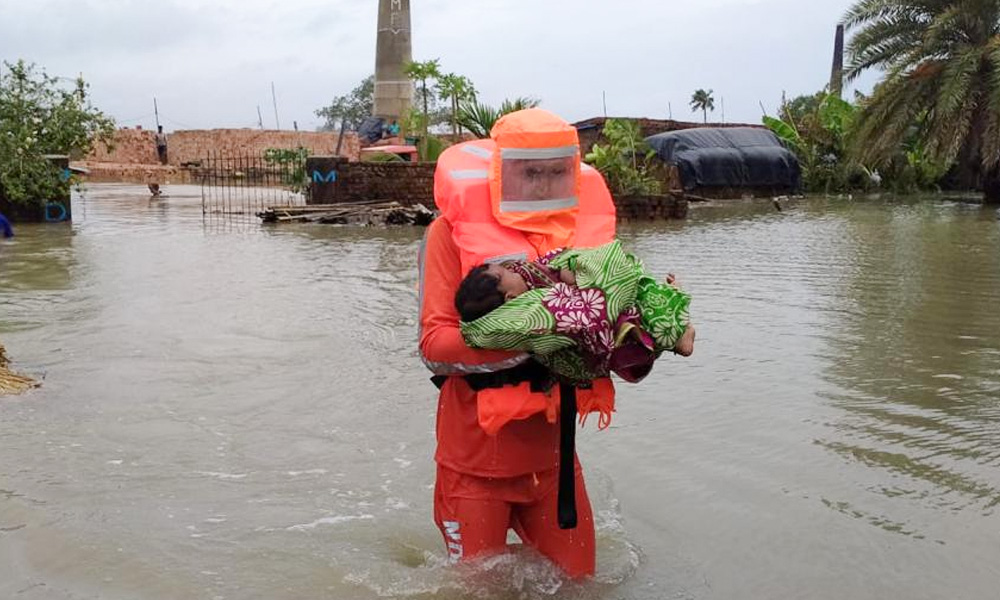
Image Credits: Twitter/TheAssamRifles
Cyclone Yaas Lays Destruction In 4 States Of India Amid COVID Pandemic: Know All About It
Writer: Hannah Jacob
Hannah Jacob P is an observant and passionate young woman who loves to find unheard stories and help to make anyone's day better through those stories. Besides searching for social impact stories, she loves to read about human behavior.
India, 29 May 2021 6:47 AM GMT
Editor : Palak Agrawal |
Palak a journalism graduate believes in simplifying the complicated and writing about the extraordinary lives of ordinary people. She calls herself a " hodophile" or in layman words- a person who loves to travel.
Creatives : Palak Agrawal
Palak a journalism graduate believes in simplifying the complicated and writing about the extraordinary lives of ordinary people. She calls herself a " hodophile" or in layman words- a person who loves to travel.
Prime Minister Narendra Modi on Friday, May 28, announced financial assistance of ₹1000 crore for the work to be undertaken in cyclone-affected areas. Odisha has been allocated ₹500 crores and the remaining have been granted to West Bengal and Jharkhand.
Amid the second wave of the coronavirus pandemic and days after cyclone Tauktae ravaged the states on the western coast of the country, a severe cyclonic storm named 'Cyclone Yaas' has caused destruction, leaving thousands homeless in the states of Odisha, Jharkhand, and West Bengal in the last few days.
Climate scientists predict that the severe cyclonic storms in the Bay of Bengal are being triggered due to climate change, reported by The Times of India. The water around the Indian sub-continent has become warmer over the years thereby providing the ideal temperature for frequent cyclones to form near the area. Below is a timeline of the cyclone entering India and its further reduction into a low-level depression.
Timeline OF Cyclone Hitting India And Reducing To Low-Level Depression
May 23: A low pressure formed in the Bay of Bengal had intensified into a storm and the India Meteorological Department (IMD) had predicted that it would turn into a 'severe cyclonic storm' and affect the states of Odisha and West Bengal with high rainfall in the subsequent days. The Indian Railways had cancelled over 100 special trains going to Odisha.
May 24: The cyclone had received the name of 'Yaas' and continued to move across the Bay of Bengal and into the state of Odisha. Odisha had put four districts on high alert.
May 25: IMD had released a tweet that the cyclone had entered the district of Balasore in Odisha.
May 26: The cyclone had crossed the north coast of Odisha at its peak intensity. The IMD had released a bulletin updating the current location of the cyclone and its further movements.
May 27: The depression had moved over to south Jharkhand and Kolkata received moderate rainfall. Domestic airports which had been suspended resumed operations in the afternoon. Reports stated several regions in West Bengal were under water. The state had conducted its biggest evacuation of 15 lakh people to 14,000 relief camps in 72 hours, reported by The Times of India.
May 28: Owing to the intensity, shops and houses had been washed away in a village in West Bengal's Purba Medinipur. Yellow alert had been issued in Northwest and central Bihar, and flights from Patna had been suspended. By mid-morning, the depression in Bihar had weakened into a well-marked low lying area, revealed a tweet by IMD.
The cyclone entered Jharkhand where four reportedly died in incidents of lightning and electrocution. At least 11 people have been reported dead and nearly 16 lakh people have been affected.
Relief Announced
Prime Minister Narendra Modi on Friday, May 28, announced financial assistance of ₹1000 crore for the work to be undertaken in cyclone-affected areas. Odisha has been allocated ₹500 crores and the remaining have been granted to West Bengal and Jharkhand, according to News18.
West Bengal Chief Minister Mamata Banerjee pegged losses to the tune of ₹ 15,000 crore due to the natural calamity, according to NDTV.
The state government allocated ₹1,000 crores for relief work in the cyclone-hit areas and announced the launch of her Duare-Tran (relief at doorstep) scheme beginning next month.
Meanwhile, Bihar announced a compensation of ₹ 4 lakh each for families of those who died due to cyclone.
In Odisha, over 120 village settlements were drenched by heavy rains, however, no deaths have been reported. Four people including two minors have been reported dead in Jharkhand. 17,000 people have been evacuated and 300 houses have suffered flooding in Jharkhand. Bihar continues to be flooded with rainwater.
Preparations Made
Odisha
The state government had extensively prepared for this storm by early evacuations and deploying Odisha Disaster Rapid Action Forces at areas of high alert. On May 24, 10 districts had been put on high alert and disaster management officers have been deployed in the area.
"We have already deployed 22 units of the National Disaster Response Forces, 50 Odisha Disaster Rapid Action Forces, 175 fire service teams and 35 specialised-tree cutting teams," said Pradeep Kumar Jena, Special Relief Commissioner of Odisha to The Hindu.
The state had also cancelled all COVID-19 testing, vaccination and leave for officials. Doctors had been sent to Balasore and Bhadrak district to assist in the process. About 140 cyclone shelters and 1,102 alternative shelters have been readied by the government. Following the storm, CM Naveen Patnaik has announced to take an aerial survey of the damage caused.
West Bengal
The Chief Minister had said that the state had taken all the precautionary measures to deal with the storm and a control center has been set up where she will stay to monitor the situation at Nabanna
PM Narendra Modi had also tweeted regarding his aerial survey and his review of the damage caused by the cyclone and announced appropriate relief measures. He also conducted d a review meeting with the respective Chief Ministers.
Also Read: Centre To Provide Rs 5 Lakh To Families Of Journalists Who Died Of COVID
 All section
All section













